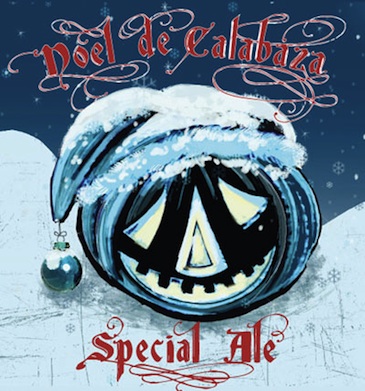Chicagoist's Beer Of The Week: Jolly Pumpkin's 'Noel de Calabaza'
By Jason Baldacci in Food on Jan 4, 2013 8:40PM
 The problem that breweries have when they make winter releases with the words "Christmas" or "Noel" on the label is that a lot of people won't buy those beers on December 26. This week, we're taking the opportunity to encourage the beer drinking public to keep consuming these beers into the new year, despite their names, and possibly even consider buying a bottle to lay down in your cellar (ie: pantry/closet/parent's basement) until the next holiday season.
The problem that breweries have when they make winter releases with the words "Christmas" or "Noel" on the label is that a lot of people won't buy those beers on December 26. This week, we're taking the opportunity to encourage the beer drinking public to keep consuming these beers into the new year, despite their names, and possibly even consider buying a bottle to lay down in your cellar (ie: pantry/closet/parent's basement) until the next holiday season.
Our shining example of one of these beers is the "Noel de Calabaza" from Jolly Pumpkin Artisan Ales in Dexter, Michigan. The beer pours a deep mahogany color into the glass with sharp, almost frothy carbonation. We get prevalent notes of figs, dark berries, and stone fruit on the nose, along with a hint of sour apple (in a good way). On the palate, there's a tart acidity that races over the tongue and unfolds all of those things we found in the aroma. The figs are there, but they seem to have been spiced, while the berries and stone fruit might as well have been baked into a pie. At 9 percent alcohol content, the "Noel de Calabaza" is incredibly complex, a little sour, and not for the faint of heart. Jolly Pumpkin has a very unique brewing process in which they open ferment their beers and mature them in oak barrels, then blend different batches together when they bottle. You can read more about it here.
When you decide to cellar a beer, you're always taking a risk. Most beer is meant to be consumed as fresh as possible, which is why a lot of breweries put code dates on their bottles and go to great lengths when it comes to quality control. While certain beers will definitely age pleasantly, it's important to remember that unlike wine, beer doesn't necessarily get better with age, it just gets different. If you're going to cellar beer, there are three things to look for that will help the process work in your favor. First, you'll do well if the beer has a relatively high alcohol content. Something that's over 8 percent is going to prove a heartier brew, and has a better chance of holding up over time. Second, look for beers that are darker in color. Dark beers get a lot of their flavor from heavily roasted grains instead of relying on hops, which is helpful when cellaring since hop aromas are one of the first things that will fade in a beer as it ages. Last, look for beers that have been bottle conditioned. Bottle conditioning is a process that naturally carbonates beer by re-fermenting it in the bottle, and it helps give beer a longer shelf life. Most Belgian breweries bottle condition, which is why a lot of Belgian Ales come with very active carbonation. So instead of laying down your favorite pilsners or pale ales, we'd recommend building your cellar with Imperial Stouts and Belgian or Belgian-Style Dark Ales, like "Noel de Calabaza."
You can still try the "Noel de Calabaza" on tap at the Map Room or the Green Lady, or there's a good chance you can still pick up a 750ml bottle of it at your favorite bottle shop. We recommend buying two. One for now, and one for next Christmas.